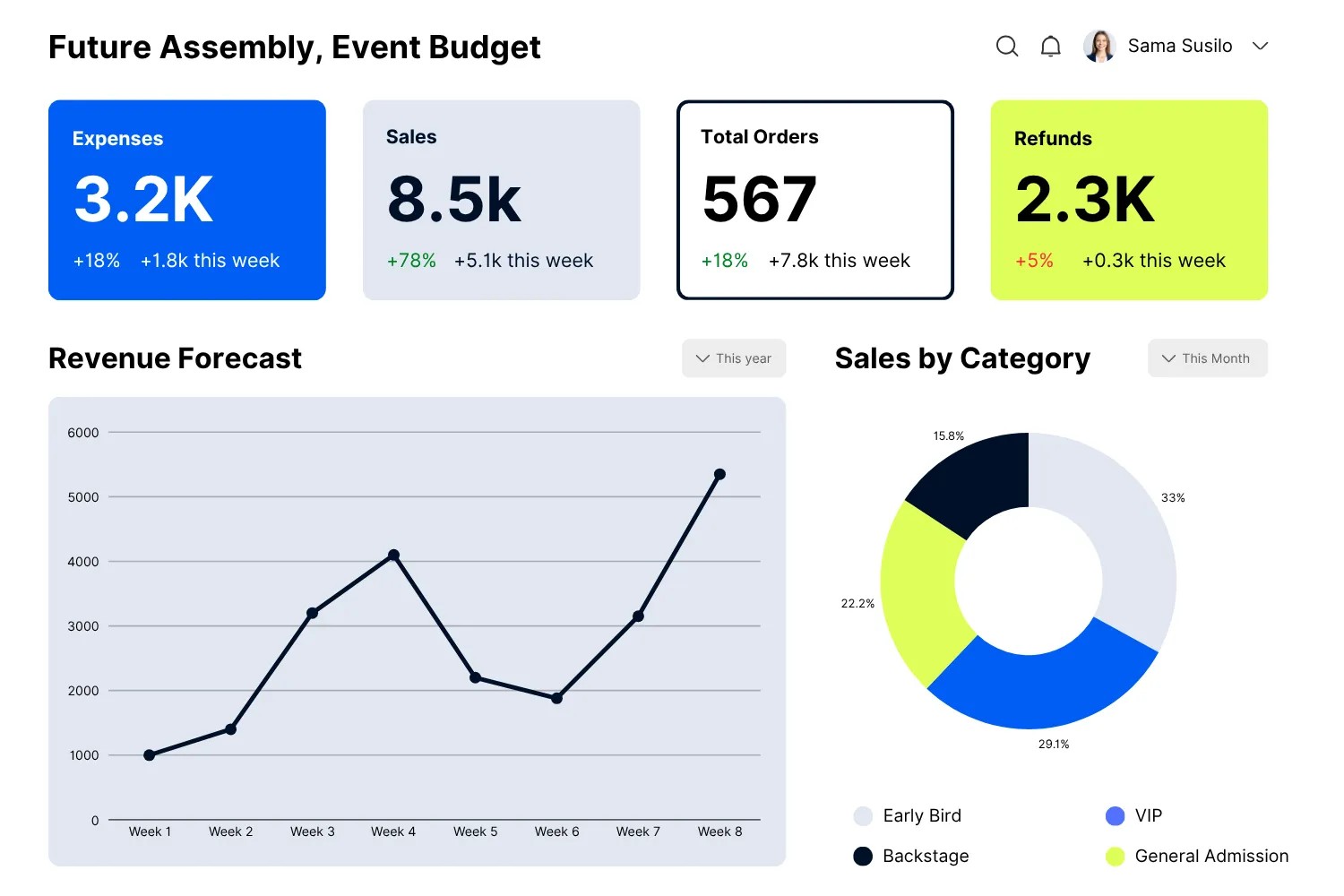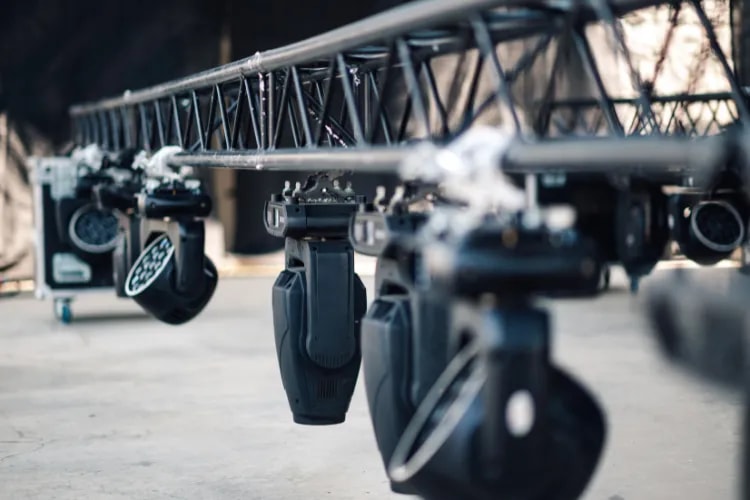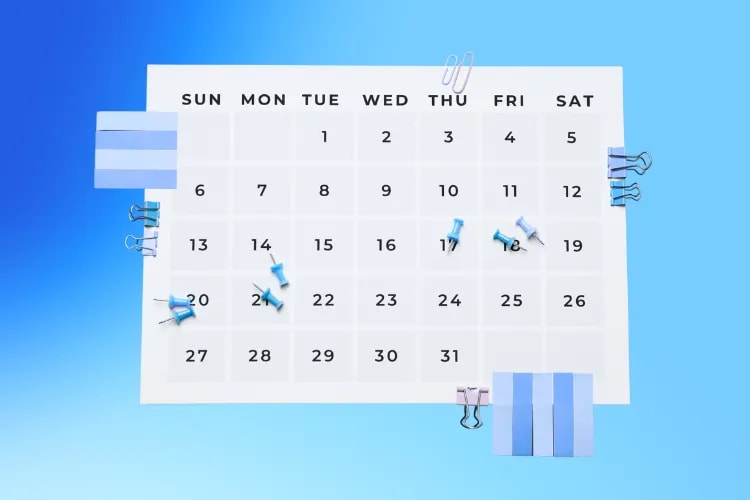
Event budgets are feeling the squeeze. Per‑attendee meeting costs climbed in 2024 and are projected to keep rising in 2025, while hotel rates remain elevated—pushing planners to rethink destinations and negotiate harder. As one global forecast notes, price pressures are stabilizing but still above pre‑pandemic baselines, making disciplined budgeting non‑negotiable. (GBTA/CWT forecast)
Whether you’re hosting a 120‑person leadership retreat, a 5,000‑attendee conference, or a neighborhood festival, a strong event budget is your strategy—expressed in numbers. It tells you what you can deliver, where you can stretch, and how to protect margin without sacrificing attendee experience.
In this guide, you’ll learn why a thoughtful event budget matters, how to build one step by step, where to find savings without cutting value, and how to track it in real time. We’ll share practical templates, negotiation moves, and examples you can adapt for your next event.

The Loopyah Content Team shares expert insights, practical guides, and industry updates to help event organizers create unforgettable experiences and stay ahead in the event planning world.
planning
` like F&B and AV are rising faster than inflation and fewer than half of planners expect bigger budgets in the year ahead. (PCMA meetings market survey)
Financial control and transparency: See where every dollar goes and why. Clear categories, owners, and approvals reduce surprises and last‑minute scrambles.
Avoid overspending and debt: Guardrails and contingency protect cash flow and keep the show funded without panic cuts.
Maximize ROI: Link spend to outcomes (pipeline, ticket revenue, NPS, renewals) and reallocate from low‑ to high‑impact lines as the data comes in.
Attract sponsors and stakeholders: A transparent, ROI‑tied event budget builds trust and helps close sponsor deals. Check our guide on event sponsorships.
Write success first, then fund it. Before you list a single expense, clarify exactly what your event must achieve. Your goals determine scope, format, city, tech stack, and staffing—and ultimately the shape of your event budget.
Revenue goals: Ticket sales, upsell/cross‑sell, expo floor sales, sponsorship targets. Example: “$450k gross ticket revenue at 80% paid attendance.”
Audience and experience goals: NPS 60+, session satisfaction 4.5/5, accessibility compliance, CE credits delivered, community growth.
Commercial/marketing goals: Marketing‑qualified leads (MQLs), sales pipeline sourced, media impressions, content assets created.
Operational goals: On‑time launches, <1% no‑show for speakers, 100% vendor COIs on file, <2% budget variance.
Write goals first; then fund only what moves those goals. Everything else is a nice‑to‑have.
Not sure where to start? Use a structured planning workflow to define scope, timelines, and owners, then convert those decisions into budget lines. Our event planning checklist can help you lock the fundamentals before you allocate dollars.
Build a bottoms‑up estimate by category—don’t just take last year + inflation. Expect outsized growth in food & beverage and production/AV, and remember that speaker fees for headliners often land in the $10k–$50k range. Insurance, permits, and labor all need explicit lines.
Venue and rentals: Room rental, ADR blocks, service charges, furniture, staging, drape, security, power drops, internet, load‑in/out fees, cleaning, storage, union labor where applicable.
Food & beverage (F&B): Buffets vs. plated, coffee breaks, receptions, dietary accommodations, corkage, bartender fees, service and gratuity, tasting costs, surplus/leftover handling.
Production and AV: Stage design, PA, projectors/LED, cameras, recording, lighting, comms, rigging, crew, rehearsal time, travel for techs, post‑production for session videos.
Technology and platforms: Registration/ticketing, mobile app, Q&A/polling, badging/printing, lead retrieval, livestream/virtual platform, analytics, on‑site check‑in hardware.
Marketing and advertising: Paid social/search, email design, landing pages, content creation, PR, creative development, photography, videography, web updates, promo codes.
Staffing and labor: Event team, temporary staff, volunteers (merch/meals), speaker wranglers, registration desk, security, medics, cleaners, talent handlers, overtime buffer.
Speakers and talent: Honoraria/fees, travel and accommodation, green room, rider items, book signings, meet‑and‑greet staffing.
Travel and accommodation (internal): Organizer flights and hotels, per diems, local transport, baggage/shipping.
Insurance, permits, and compliance: Special event liability, vendor COIs, alcohol permits, street closures, fire marshal fees, accessibility accommodations, weather contingency provisions.
Sustainability and waste: Composting, recycling, food donation partners, water refill stations, signage reuse plan; these items can reduce disposal costs and appeal to sponsors.
Contingency and risk reserves: Align to quantified risks (weather tents, backup power, rush shipping, show‑week crew). A flat 10% is common, but risk‑based budgeting is smarter.
Tips for accurate estimates:
Get current, comparable quotes (at least three) with identical specs, dates, and quantities.
Separate hard costs from service and taxes; model total cost of ownership (TCO), including drayage, delivery, and tear‑down.
Apply realistic attendance curves (early/standard/late) and build F&B to a conservative consumption model.
For hybrid/virtual, calculate per‑viewer cost (platform + production ÷ expected digital attendance) before you green‑light livestreams.
Document vendor assumptions (labor hours, room turns, minimums) so you can compare apples to apples later.
Competitive tension saves money. Use a structured RFP with a standard spec, invite multiple qualified vendors, and request itemized pricing. Ask for creative alternates that reduce cost without hurting attendee value—like digital signage where rigging is expensive, or moving your reception one level to avoid additional power.
Run “like‑for‑like” comparisons: Same scope, dates, hours, crew, and service levels. Split quotes by rental vs. labor vs. fees for clean evaluation.
Leverage secondary markets and off‑peak windows: Shifting cities or choosing shoulder seasons can unlock lower ADRs and better concessions.
Negotiate total cost of ownership: Request fee caps, service charge clarifications, and bundle discounts (e.g., AV + wifi, or multi‑year venue deals).
Use data in negotiations: Bring competitive quotes and historical consumption to the table; let vendors win scope where they create the most value.
Zero‑based thinking helps you fund what matters and trim what doesn’t. Rank budget components by impact on your goals vs. cost. Fund must‑haves first (program content, production quality, accessibility), then allocate to strong differentiators (community activations, unique F&B), and cut or delay nice‑to‑haves until the ROI clears your hurdle rate.
Must‑haves: Safety, accessibility, core content, reliable production, registration and badging, minimal staff to run the show.
Should‑haves: Session recording for on‑demand, strong keynote talent, interactive features (live polling), solid F&B basics that reflect your brand.
Nice‑to‑haves: Upgraded swag, elaborate scenic pieces, premium lounge builds, extensive print collateral if digital substitutes work.
Example allocation for a 1,000‑attendee, two‑day conference (high‑level).Adjust for your goals (e.g., content monetization or heavy sponsor activations):
28% production/AV, 24% venue/rentals
18% F&B, 10% marketing
7% staffing
5% speakers
3% tech/platforms
2% insurance/permits
3% contingency
Your budget workbook should be both a planning tool and a daily operations control. Track estimates vs. actuals, highlight variance by category, and refresh a rolling forecast monthly (or bi‑weekly during campaign peaks) so decisions reflect reality—not a stale plan.
Essential columns: Category, Sub‑category, Vendor, Description/Scope, Assumptions, Qty/Units, Unit Cost, Estimated Cost, Actual Cost, Accruals, Variance ($/%), Payment Terms, PO/Contract #, GL Code, Owner, Due Date, Status, Notes.
Governance: Version control, change‑order log, approvals, and vendor contact sheet linked to each line item.
Dashboard: Burn‑down (budget vs. committed vs. actual), top 10 vendors by spend, variance by category, cash flow by month, revenue vs. goal, and forecasted margin.
The smartest savings come from design choices, not slashing attendee value. Use the levers below to reduce total cost of ownership while protecting the experience.
Negotiate with vendors: Request fee caps, reduced service charges, or comp rooms based on block performance; trade flexible move‑in windows for lower labor; bundle AV + internet; ask for “good/better/best” options.
Seek sponsorships and partnerships: Package assets (branding, content integrations, lead retrieval, meeting space) and price from a clean cost base. Transparently report performance to unlock renewals. Explore our guide to event sponsorship for frameworks and examples.
Use early pricing strategically: Instead of deep early‑bird discounts that can depress ancillary spend, test modest tiered pricing and value‑add bundles (e.g., “early + workshop” or “team of 4” packs). Model the net effect across revenue and staffing.
Book smart—city, venue, and season: Secondary markets and shoulder seasons often yield better concessions (wifi, meeting space, upgrades) and lower ADRs. Ask for year‑over‑year rate caps for multi‑year agreements.
Reduce waste and go green: Right‑size F&B to historical consumption; donate unused food; shift heavy prints to reusable or digital; rent scenic elements that can be repurposed. Waste avoided is budget saved.
DIY vs. outsource: Bring straightforward tasks in‑house (simple stage décor, basic video cutdowns) while outsourcing high‑impact specialties (rigging, show calling). Always price the time cost of “DIY.”
Leverage virtual and hybrid wisely: Treat digital as a product line. Calculate cost per digital attendee and monetize via virtual tickets, on‑demand access, or sponsor content. Stream only sessions that pay their way.
Mini‑case: A 900‑person B2B summit saved $86k by moving to a secondary market (‑12% ADR), consolidating their general session and awards dinner into the same room (‑1 day of rigging), and right‑sizing F&B with a 10% buffet reduction and water stations instead of bottles. Attendee NPS rose from 56 to 62.
Budgets only work if you run them in real time. Set a review cadence, automate alerts for volatile lines (paid media, F&B, AV labor), and use a rolling forecast to update your outlook as quotes firm up and registrations roll in.
Cadence: Weekly reviews during pre‑production; twice weekly in the four weeks prior; daily during show week. Keep meetings short and decisions documented.
Variance tracking: Flag variances >5% and require owner action plans (rebid, rescope, reallocate). Escalate fast if contingency drops below your risk threshold.
Change control: Log every scope change and attach approvals. Late‑breaking add‑ons are the #1 margin killer; make the trade‑off explicit.
Marketing spend governance: Use automated alerts for pacing and CPA/ROAS thresholds; pre‑approve seasonal budget adjustments to catch demand spikes without overspending.
Rolling forecast: Update revenue and cost forecasts monthly. Reallocate from under‑performing to over‑performing channels/sessions.
Example: Your paid social is pacing 25% over CPL target two weeks out. Pause the lowest‑performing ad sets, shift budget to email and partner promos, and add a sponsor‑funded discount code to stimulate late‑stage conversions without eroding net revenue.
Ready to get started with a pre-made template to manage your next event budget?
Not all events are created equal—and neither are their budgets. The structure, line items, and priorities vary dramatically depending on your event’s format, audience, and purpose. Understanding these distinctions helps you allocate more effectively and avoid over- or under-investing in the wrong areas.
For large-scale conferences and summits, your biggest costs often fall into production (AV, staging), venue, and food & beverage. These events are content-driven, so investing in quality speakers, session recordings, and technology platforms is critical.
Typical Allocation Breakdown: - 30% Production and AV - 25% Venue and rentals - 15–20% F&B - 10% Marketing - 5–10% Speakers - 3–5% Tech platforms
Trade shows are sponsor- and exhibitor-heavy. Budgeting for booth construction, exhibitor services, lead retrieval, and partner hospitality is essential. Revenue usually comes from booth sales and sponsorships, so budgeting must align with fulfillment commitments.
These are often smaller in scale but still require careful budgeting, especially for A/V, content creation, and travel logistics. ROI is measured more in engagement, alignment, and retention.
Budgets here must be lean, with a strong focus on donations, grants, or ticket revenue to offset expenses. You’ll want to carefully track in-kind donations and vendor discounts.
Typical Priorities: - Sponsorship activations - Donor recognition experiences - Cost-effective venue solutions
While virtual eliminates travel and venue costs, you’ll spend more on platforms, streaming, and production. Hybrid adds complexity: you must budget for both in-person and digital infrastructure.
Important Metrics: - Cost per digital attendee - Session engagement and drop-off rates - Monetization through on-demand content or sponsorships
A well-managed budget doesn’t just control costs—it drives results. Event ROI should be an integral part of your budgeting strategy, allowing you to justify spend, prove value, and continuously optimize.
Break down each major budget line and ask: how does this support our goals? - Revenue goals: Track ticket sales vs. spend on marketing, tech, and processing. - Lead generation: Tie sponsor exposure or activations to lead capture volume and quality. - Brand awareness: Measure impressions, reach, and engagement from event promotions.
Track not just attendance but: - Cost per lead (CPL) - Cost per opportunity - Net Promoter Score (NPS) - Customer acquisition cost (CAC) from events
As data comes in: - Shift funds toward high-performing channels (e.g., email > paid social) - Cut underperforming content or low-engagement activations - Double down on what’s working (popular sessions, high-ROI sponsorships)
Events are business investments. Use your budget to track outcomes, not just expenses.
Budget cuts happen—whether due to internal constraints, economic shifts, or unexpected cost overruns. The key is agility: being able to adjust while preserving core value.
Go back to your must-achieve objectives. What are the non-negotiables? Prioritize items directly tied to these goals and be ready to scale back or cut the rest.
Scale down: Shorten the event duration, reduce room sets, or consolidate sessions.
Change formats: Replace high-cost networking events with sponsor-hosted happy hours.
Simplify F&B: Opt for buffet over plated meals, or remove low-impact snacks.
Re-use assets: Use last year’s signage, re-edit past video content, re-theme décor.
Vendors may offer: - Reduced scope pricing - Delayed payments - In-kind upgrades (e.g., free rigging or staff)
Bring them into the conversation early.
Set expectations with stakeholders and attendees. Highlight where cuts were made thoughtfully to preserve the experience.
Even experienced planners make budgeting missteps. Learn from common pitfalls to keep your event on solid financial ground.
Costs change. Starting with last year’s numbers and adding a flat percentage increase can miss major market shifts—especially in labor, F&B, and tech.
Overlooked expenses like service charges (which can hit 25%+), overtime, and setup fees create painful surprises. Always budget for full cost of ownership.
No-shows, late registrations, and speaker drop-offs affect spend and ROI. Model different attendance curves and be conservative with F&B and materials.
Without a single source of truth (and good change tracking), team members may rely on outdated budgets—leading to overcommitment or errors.
Hourly rates + overtime + weekend premiums = fast escalation. Always get labor estimates in writing and ask for all-inclusive packages.
Avoiding these errors protects your margin—and your sanity.
Modern events are built by cross-functional teams—marketing, operations, finance, and external vendors. Budget collaboration is critical to avoid waste, confusion, and misalignment.
Choose a cloud-based spreadsheet or platform where all stakeholders can: - View real-time updates - Add notes or changes with version control - Tag owners and due dates
Set clear responsibilities: - Who owns each category? - Who signs off on changes? - Who reports variance and updates forecasts?
Link budget lines to timelines, contracts, and deliverables. This prevents duplicate spending and helps align budget pacing with event milestones.
When teams understand what “success” looks like (e.g., leads, ticket revenue, satisfaction scores), it’s easier to prioritize spend and cut waste.
A budget is a shared blueprint—not a siloed spreadsheet. Make it collaborative.
Concrete examples help contextualize best practices. Here are anonymized budget breakdowns from real events:
Audience: 1,200 B2B attendees
Format: 2-day, in-person conference
Top Allocations: - AV & Production: $75,000 - Venue & Rentals: $60,000 - F&B: $45,000 - Marketing: $30,000 - Speakers: $20,000 - Tech/Platform: $10,000
ROI: $620k in ticket revenue, 700 new MQLs, 72 NPS
• Audience: 250 donors and stakeholders
• Format: Evening fundraiser with silent auction
Top Allocations: - Venue: $8,000 (donated in-kind, but listed at fair market) - Catering: $10,000 - Decor & Print: $3,000 - Auction Tech Platform: $2,500 - Entertainment: $3,000
ROI: $85,000 raised
Examples help demystify how far a budget can go—and how to tailor spend by goal.
Start simple, then add sophistication as you scale. A well‑structured spreadsheet beats a fancy tool you won’t keep updated. As your program grows, layer in dashboards and automations that surface risks early and keep stakeholders aligned.
Spreadsheets: Google Sheets or Excel with protected ranges, data validation, and a summary dashboard (budget vs. committed vs. actual).
Templates: Start from a standard event budget template with categories for venue, F&B, AV, tech, marketing, staffing, insurance/permits, and contingency.
Collaboration: Centralize contracts, quotes, and invoices. Link each line item to its source file for auditability and faster approvals.
Marketing and attendee comms: Coordinate registration promos, email schedules, and sponsor deliverables to avoid last‑minute rush fees and reprints.
Want fresh promotion tactics to improve your paid/owned/earned mix and get more value from your budget? Explore these creative event promotion ideas to boost demand without overspending.
A great event budget won’t land unless it gets approved. Presenting your budget strategically to execs, finance teams, or sponsors ensures buy-in and support.
Frame the budget around goals: - “This spend supports lead generation by enabling X.” - “This F&B allocation ensures we meet accessibility and wellness goals.”
Use charts and dashboards to show: - Allocation by category - Forecasted vs. actual spend - Expected ROI or breakeven
Visual storytelling makes budgets easier to grasp and approve.
Preempt concerns by: - Offering tiered options (Good / Better / Best) - Highlighting where costs are rising and why (e.g., union labor, hotel ADRs) - Showing areas of savings or in-kind support
Finance wants clean numbers. Executives want strategic outcomes. Sponsors want ROI. Customize your pitch to the audience.
Approach your budget presentation like your event pitch—with a clear narrative, aligned goals, and a path to success.
Costs may be stabilizing, but they’re still elevated. Teams that define goals first, estimate comprehensively, competitively source vendors, and track variance in real time protect both ROI and attendee experience. Treat your event budget as a living plan: build it carefully, review it weekly, and be ready to reallocate dollars to what’s working.
Ready to put this into action? Start with a clean, structured template and adapt it to your program. Lock your categories, get three quotes for every major line, and set your review cadence now so you can make smarter, faster decisions as the event approaches.

planning









planning
planning
planning
planning
growth
planning
planning
planning
planning